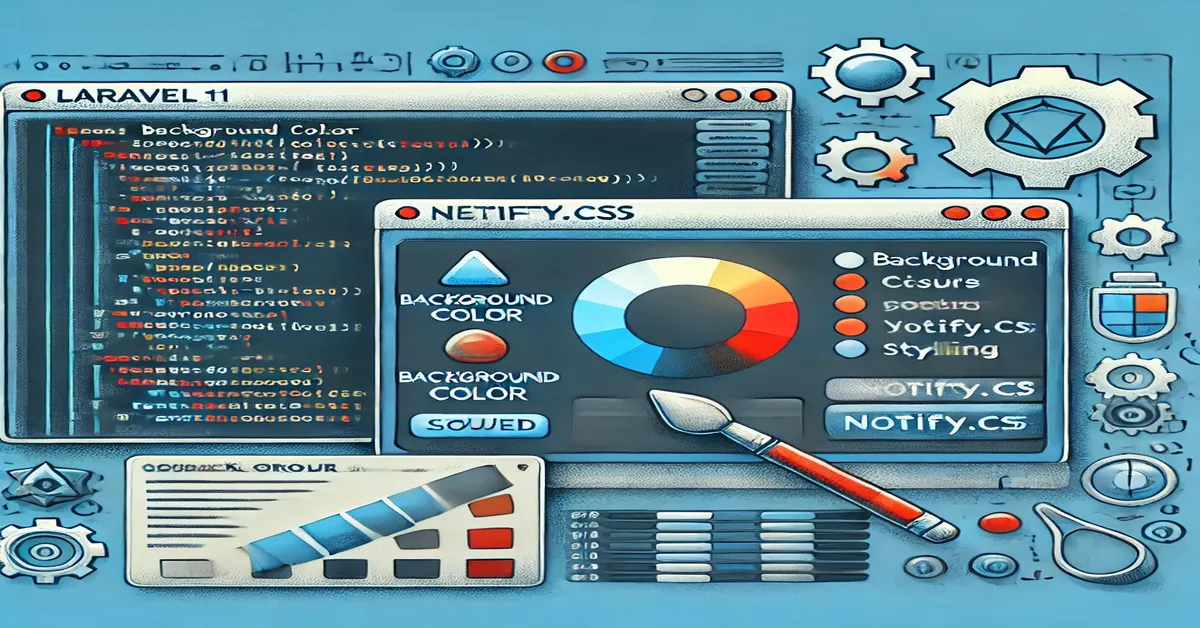As Laravel evolves, each new version brings enhancements and features that improve the developer experience. Laravel 11 has introduced some significant updates; however, when using third-party libraries like Notify.css, developers might notice issues, such as unintended background color changes. This article explores the background color challenges associated with Notify.css in Laravel 11, providing solutions to address these issues and best practices laravel 11 notify.css affecting background color for maintaining design consistency.
Understanding Notify.css and Laravel 11
What is Notify.css?
Notify.css is a lightweight CSS library that offers simple, easy-to-use notification messages for web applications. It doesn’t rely on JavaScript, making it a popular choice for minimalist projects where custom notification styling is needed. Notify.css is designed to provide a variety of notification styles, from subtle alerts to more attention-grabbing messages, which can be triggered directly through CSS classes.
Laravel 11 Overview
Laravel, a leading PHP framework, is popular for its robust architecture, allowing for rapid development while maintaining code quality. Laravel 11 has introduced several updates, including improved error handling, new middleware capabilities, and refined support for modern front-end tools. These upgrades, while beneficial, can sometimes lead to compatibility issues with external libraries like Notify.css, especially when it comes to CSS styling conflicts.
Notify.css and Background Color Issues in Laravel 11
One common issue developers face is that Notify.css notifications may adopt unintended background colors when integrated with Laravel 11. This behavior can be frustrating, especially if it interferes with a site’s established design. The issue can stem from various sources, such as global CSS conflicts, custom themes, or specific settings in Laravel 11’s new front-end asset management pipeline.
Common Symptoms
- Unintended Background Colors: Notify.css notifications may display a background color that differs from the intended color.
- Inconsistent Styles Across Pages: Notify.css styles may vary from page to page due to cascading issues in the CSS.
- Style Overriding by Global CSS: Global styles in Laravel may override Notify.css, causing conflicts in the design.
Root Causes of Background Color Conflicts
To resolve these background color conflicts effectively, it’s essential to understand their root causes. Common reasons for these issues include:
1. Global CSS Overwrites
Laravel’s app.css file or other globally applied stylesheets may include styles that inadvertently affect Notify.css elements. This can happen if there laravel 11 notify.css affecting background color are overlapping class names or general selectors that interfere with Notify.css classes.
2. CSS Specificity Conflicts
CSS specificity determines which styles are applied when multiple rules could apply to the same element. If Notify.css styles have lower specificity than Laravel’s global or custom styles, they may be overwritten, causing unexpected background color changes.
3. Front-End Asset Compilation Issues
Laravel 11’s updated asset compilation system, using tools like Vite, may cause Notify.css styles to be bundled or prioritized incorrectly. This can lead to situations where Notify.css background colors are either overridden or not applied correctly.
4. Custom CSS Variables
In Laravel 11, developers often use CSS variables for consistency and easy theme management. However, if Notify.css doesn’t incorporate these variables, the background colors may appear out of sync with the rest of the application.
5. Tailwind CSS or Bootstrap Integration
If your Laravel application uses Tailwind CSS or Bootstrap alongside Notify.css, conflicting utility classes or CSS resets may disrupt Notify.css’s background color styles. Since these frameworks use utility classes to set background colors and other styles, they may override Notify.css notifications.
Solutions to Fix Background Color Issues in Notify.css
Resolving these issues involves a multi-step approach, which can vary based on the specific setup and the type of conflict encountered.
Solution 1: Increase CSS Specificity
One straightforward fix is to increase the specificity of Notify.css styles, ensuring they take precedence over any conflicting styles from Laravel’s app.css or other frameworks.
Example:
cssCopy code/* Original Notify.css */
.notify-success {
background-color: #4caf50;
}
/* Higher Specificity */
body .notify-success {
background-color: #4caf50 !important;
}
Using !important sparingly can be beneficial, especially when dealing with framework conflicts, but should be used cautiously as it can complicate future styling changes.
Solution 2: Separate Notify.css into an Isolated Scope
Encapsulating Notify.css within a specific HTML class or ID can help ensure that its styles don’t interfere with global CSS. This technique, often referred to as CSS scoping, can effectively isolate Notify.css.
Example:
htmlCopy code<div class="notify-scope">
<!-- Notify.css notifications here -->
</div>
CSS:
cssCopy code.notify-scope .notify-success {
background-color: #4caf50;
}
By limiting Notify.css to a scoped container, you reduce the chances of it being impacted by global styles.
Solution 3: Adjust Compilation with Vite
Laravel 11 uses Vite as the default asset bundler. To control how Notify.css is compiled, consider creating a separate entry point or loading it last in the CSS import order.
In your vite.config.js:
jsCopy codeexport default defineConfig({
css: {
preprocessorOptions: {
css: {
additionalData: `
@import "resources/css/notify.css";
`,
},
},
},
});
This approach ensures Notify.css is loaded as intended, reducing the risk of background color conflicts with other styles.
Solution 4: Use Inline Styling for Critical Notifications
If specific notifications require fixed background colors, applying inline styles within the component or notification trigger can prevent conflicts. Inline styles have the highest specificity and will override external styles.
Example:
htmlCopy code<div class="notify-success" style="background-color: #4caf50;">
Success!
</div>
Solution 5: Integrate CSS Variables into Notify.css
For Laravel applications with a CSS variable-based theme, modifying Notify.css to use these variables can help achieve a more consistent look across the site.
Example: In your Laravel app’s global CSS:
cssCopy code:root {
--notify-success-bg: #4caf50;
}
And in Notify.css:
cssCopy code.notify-success {
background-color: var(--notify-success-bg);
}
This approach not only resolves color conflicts but also enhances theme consistency.
Solution 6: Modify or Extend Notify.css Classes in Tailwind CSS or Bootstrap Projects
If you are using Tailwind or Bootstrap, defining custom utilities or extending Notify.css classes within Tailwind’s configuration or Bootstrap’s SCSS files can provide more control.
For Tailwind CSS:
jsCopy codemodule.exports = {
theme: {
extend: {
backgroundColor: {
'notify-success': '#4caf50',
},
},
},
};
For Bootstrap:
scssCopy code.notify-success {
background-color: $primary-success-color;
}
By creating tailored configurations, laravel 11 notify.css affecting background color you reduce conflicts with Notify.css’s default classes.
Best Practices for Using Notify.css in Laravel 11
- Audit CSS Specificity Regularly: Periodically check which styles are being applied to your notifications. CSS specificity audits can reveal unintended overrides that may affect Notify.css.
- Utilize Scoped Stylesheets: Limit Notify.css to specific components or containers within your Laravel app to avoid conflicts with global styles or other frameworks.
- Consistent Testing Across Pages: Since Laravel apps often involve dynamic content, it’s essential to test Notify.css notifications across different views to catch any inconsistencies early.
- Check Compilation Order in Vite: The order in which CSS files are imported can affect which styles get applied. Ensure that Notify.css is loaded in the desired order to minimize conflicts.
- Update Notify.css When Possible: As Notify.css releases updates, staying current with its latest versions can help address compatibility issues, especially as new Laravel features emerge.
- Limit Use of
!important: While useful in some cases, overuse of!importantcan complicate debugging and CSS maintenance in the long run. Use it only when other solutions don’t suffice.
Conclusion
Notify.css is a powerful tool for creating engaging notifications within Laravel applications, but integrating it into Laravel 11 can introduce challenges, especially with background colors. By identifying the root causes of CSS conflicts and applying targeted solutions, developers can ensure that Notify.css performs as intended. Following best practices like increasing CSS specificity, scoping styles, and utilizing Laravel’s asset compilation tools will provide a seamless notification experience for users.
As Laravel continues to evolve, maintaining a proactive approach to CSS management will help keep your applications visually consistent and functional.
FAQs
How can I prevent global CSS from affecting Notify.css in Laravel 11?
To avoid global CSS conflicts, increase the specificity of Notify.css styles or scope Notify.css within a container to prevent interference from global styles.
Why are my Notify.css notifications showing unexpected background colors?
This issue usually arises from conflicting styles with global CSS or CSS frameworks like Tailwind or Bootstrap. Adjusting specificity or using scoped CSS can help resolve it.
Can I use inline styles with Notify.css to fix background color issues?
Yes, using inline styles for critical notifications is effective as inline styles have the highest CSS specificity, preventing other styles from overriding them.
How can I integrate Notify.css with Laravel’s theme variables?
Define your background color as a CSS variable in Laravel’s root styles, then
reference these variables in Notify.css to ensure color consistency.
What is the role of Vite in handling CSS in Laravel 11?
Vite compiles and bundles CSS in Laravel 11, determining the order of style application. Adjusting the import order in vite.config.js can help manage conflicts.
Should I use !important to fix CSS conflicts with Notify.css?
Using !important sparingly can help resolve conflicts, but it should be a last resort as it can make future styling adjustments more challenging.











